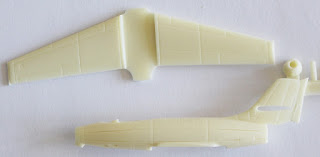1/144 Yakovlev UT-2 (2 in 1 Box) - Mikro-Mir (Mikr-Mir)
The Yakovlev UT-2 (NATO reporting name "Mink") was a single-engine tandem two-seat low-wing monoplane that was the standard Soviet trainer during the Great Patriotic War. It was used by the Soviet Air Force from 1937 until replaced by the Yakovlev Yak-18 during the 1950s.
The preceding U-2 (Po-2) biplane was no longer a suitable trainer for the faster modern aircraft entering service, and to fill the role, the UT-2 was designed as a trainer.
The new aircraft was designed by Alexander Sergeevich Yakovlev's team at OKB-115. Originally designated AIR-10, it was based upon the AIR-9, but it was simpler, with tandem open cockpits, also omitting slats and flaps. It first flew on 11 July 1935. The AIR-10 won the competition in 1935 and, after minor changes, was accepted as the standard Soviet Air Force trainer.
The wood-and-metal mixed construction of the AIR-10 was simplified to use only wood to facilitate production, and the AIR-10s 120 hp Renault inline engine was replaced with the 112 kW (150 hp) Shvetsov M-11E radial on the prototype, and the 82 kW (110 hp) M-11Gs in early production aircraft. Serial production started in September 1937. The Soviet VVS (Air Force) assigned the aircraft the designation UT-2 (uchebno-trenirovochnyi, trainer).
The UT-2 was not easy to fly and easily entered into spins. The UT-2 model 1940 featured a lengthened forward fuselage, and a change to the 93 kW (125 hp) M-11D radial to attempt to rectify the problem. Despite improvements, the handling and flight characteristics remained challenging.
To further improve handling and stability, the new UT-2M (modernized) variant was developed in 1941 and it replaced the original UT-2 in production. The wing planform was redesigned, with a swept leading edge and a straight trailing edge, and the vertical stabilizer was enlarged.
7,243 UT-2 of all types were produced in five factories between 1937 and 1946. In the 1950s, the UT-2 was replaced by the Yak-18 primary trainer and the Yak-11 advanced trainer.
Before and after World War II the UT-2 was used by civilian organizations, and after the war, UT-2s were also operated by the Polish and Hungarian Air Forces.
http://www.mikro-mir.com/en/300.html
http://www.mikro-mir.com/images/phocagallery/Avia/avia-144/ut2/instr.pdf
https://en.wikipedia.org/wiki/Yakovlev_UT-2
Estimated Release: August 2017





























